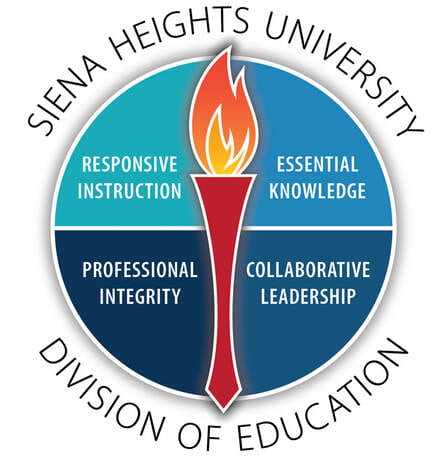Division of Education Conceptual Framework
History and Context of the Institution
Siena Heights University (SHU) advances the professional and personal goals of men and women by providing demanding and supportive experiences. A Catholic institution steeped in the Adrian Dominican tradition, the University assists people to become more competent, purposeful, and ethical through a teaching and learning environment which respects the dignity of all.
SHU was founded as St. Joseph College in 1919 and focused initially on producing teachers and administrators for Catholic schools. Renamed Siena Heights College in 1939, the institution began expanding undergraduate programs and added graduate degrees. By the 1950s, it was recognized as one of the nation’s 10 best liberal arts colleges for women. In 1969, the college became co-educational and expanded curriculum to include programs in business and human services. The 1970s saw the establishment of degree completion centers in Southfield, Michigan, and Toledo, Ohio, to provide learning opportunities to adult students via evening and weekend classes. The expansion off-site of the main campus in Adrian would continue and thrive into the present; the University now stretches to eight locations in Michigan: Lansing, Jackson, Southfield (Metropolitan Detroit), Battle Creek, Kalamazoo, Dearborn, Monroe, and Benton Harbor.
Accreditation
Siena Heights University’s Division of Education was granted national accreditation by the Council for the Accreditation of Educator Preparation (CAEP) for the full seven years, from Spring 2020 to Spring 2027. This accreditation certifies the forenamed professional initial certification programs has provided evidence of meeting all CAEP’s standards. In addition, the Division of Education is also accredited through the Higher Learning Commission (HLC), which is a regional accreditation, and has State of Michigan approval for all certification programs.
The Educator Preparation Provider (EPP)
The Division of Education, housed under the College of Arts and Sciences and the Graduate College, is the EPP at Siena Heights University. The EPP was accredited by the Teacher Education Accreditation Council (TEAC) in 2013 and is prepared to continue demonstration of its commitment to continuous improvement through the Council for the Accreditation of Educator Preparation (CAEP). Further, certification programs are approved by the Michigan Department of Education (MDE). The EPP also participates in all university-wide accreditation activities required by the Higher Learning Commission (HLC). The EPP offers undergraduate and graduate degree and certification programs in the following areas:
– Early Childhood Education/ Child Development
– Elementary Education: Language Arts, Math, and Integrated Science
– Secondary Education: Mathematics, Biology, Chemistry, English, Integrated Science, History, Social Studies, and Spanish
– K-12: Music Education and Visual Arts Education
– Special Education: K-12 Learning Disabilities and Cognitive Impairment
History and Development of the Conceptual Framework
Much discussion went into the formulation of the learning outcomes for each of the education program areas, and in 1990, the Teacher Education Program faculty (both full-time and adjunct), identified a set of overall learning outcomes for candidates preparing to become teachers. By 1992, these outcomes were included in each course syllabus, with a brief explanation of the connection between the course and specific outcomes. In 2009, the Graduate and Undergraduate Teacher Education Program Learning Outcomes (see appendix A) were streamlined and revised for greater coherence and adherence to Michigan standards and TEAC quality principles. In May 2018, the EPP considered adopting the 2017 InTASC Standards (see appendix B) as its primary learning outcomes. In the Fall of 2018, however, the EPP felt the current outcomes were still valid and reflected best practices, and therefore retained. As a team, in Fall 2018, the EPP developed a conceptual framework that refines and anchors its identity according to the University mission and the EPP outcomes. Faculty met to pull together critical theoretical perspectives, philosophical beliefs, and professional orientations that have guided the EPP in its production of highly effective educators. As a result of the reflective discussions and meetings, the mission, vision, and conceptual framework for the EPP were developed.
Mission and Vision of the EPP
University Mission:
The mission of Siena Heights, a Catholic university founded and sponsored by the Adrian Dominican Sisters, is to assist people to become more competent, purposeful, and ethical through a teaching and learning environment which respects the dignity of all.
EPP Mission:
Develop exceptional educators who collaborate and lead with intention and integrity.
EPP Vision:
Advancing educational leaders who are dedicated to ethical conduct, innovation, collaboration, and are committed to the dignity and development of the whole person.
Responsive Instruction:
We believe fundamentally that educators must have the skills to teach in diverse settings and be responsive in his or her instruction through differentiation. This proactive approach allows for all students’ needs to be met. With responsive instruction, educators incorporate assessment, student-centered learning, and quality relationships while creating a positive and supportive learning environment (Tomlinson, 2001, 2003).
Essential Knowledge:
Our beliefs also extend to the importance of educators having specific content and disciplinary knowledge (MetLife Survey, 2006). “Teachers must know the subject they teach. Indeed there may be nothing more foundational to teacher competency. The reason is simple: Teachers who do not themselves know a subject well are not likely to have the knowledge they need to help students learn this content” (Ball, Hoover-Thames, & Phelps, 2008, p. 404). With-that-said, content knowledge must also be associated with pedagogical practices.
Professional Integrity:
We also believe that integrity is essential for educators. Educators must execute ethics though confidentiality, advocacy, and honesty. “Decisions are made in the best interest of the students” (Danielson, 2007, pp. 106-107). Educators also “…demonstrate a commitment to professional standards in problem solving and decision making…maintain an open mind and are willing to attempt new approaches to old problems…” (Danielson, 2007, p. 107). Having integrity also means continuous self-improvement and professional growth (In-TASC, 2013).
Collaborative Leadership:
Finally, we deem that educators need collaborative skills and assume leadership roles. Collaborative leadership is working with students to meet their needs, while working with families, and other professionals in educational settings. Collaboration supports the process of data, the goals, and the evaluation of progress (In-TASC, 2013). Collaboration is also the “…common thread of school reform” while promoting “…shared responsibly and outcomes” (Friend & Cook, 2017, p. p.3-8). With true collaboration comes trust and the establishment of community.
Dominican Perspective-The Torch of Truth:
Light has long been a symbol of knowledge: Learning allows us to “throw light on a subject.” The Dominicans trace their roots to the thirteenth century when the torch was an instrument of light. Formed to preach truth in response to those who distorted an understanding of human dignity, the early Dominicans were found in the universities of Europe in preparation for their teaching/ preaching mission. Hence, the torch of truth became a Dominican symbol, one memorialized in the pre-graduation ceremony in which a graduate passes on a torch (candle) to an underclass member who will continue the search for truth.
Catholic Perspective:
The quadrants are formed by an embedded cross, a symbol of Siena’s growth from Christian, Catholic tradition. This tradition calls us to recognize the loving presence of God in others and all of creation and to serve others as Jesus did—with respect for the dignity of all.
Research Base of the Conceptual Framework
Teaching is an Art and a Science
Responsive instruction, essential knowledge, professional integrity, and collaborative leadership as an art is based on the creative process. According to Marzano (2007), teachers utilize the creative process to meet the needs of all learners. There is no one-size-fits-all process in teaching. Finding ways to differentiate learning to meet student individual needs is both challenging and exciting. “Differentiated instruction is responsive instruction. It occurs as teachers become increasingly proficient in understanding their candidates as individuals, increasingly comfortable with the meaning and structure of the disciplines they teach, and increasingly expert at teaching flexibly in order to match instruction to candidate need with the goal of maximizing the potential of each learner in a given area” (Tomlinson, 2003, p. 3). Differentiation of instruction supports the ability and skill set to be pedagogically and culturally responsive. In order to differentiate, a candidate must also be masterful in content, while collaborating with professional integrity for the benefit of the student.
Responsive instruction, essential knowledge, professional integrity, and collaborative leadership as a science is based on the research and theories within the pedagogy of teaching. According to Marzano (2007), these include, “…use of effective instructional strategies, effective management strategies, and effective classroom curriculum design strategies” (p.6). In the Division of Education, candidates are taught these pedagogical aspects and apply them in a multitude of clinical field placements culminating in the capstone student teaching experience. Further, candidates embrace scholarly inquiry based on reflective analysis to inform teaching effectiveness and professional growth, both in formative and summative assessments.

